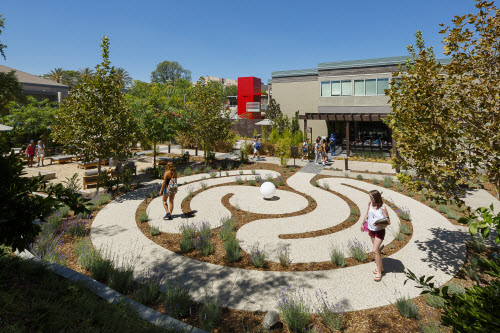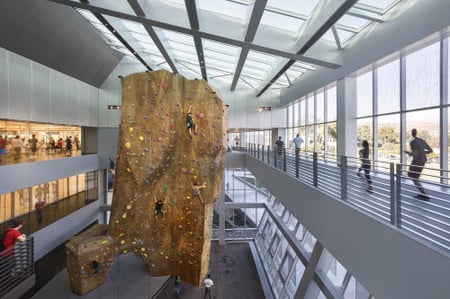The Secret to Making Wellness Work
Campuses are trailblazers in developing ROI from wellness and recreation facilities.
 California State University Northridge (CSUN) administrators had specific goals when they decided to build a 5,800-square-foot wellness center on campus, complete with therapy lounges, landscaped gardens and nap pods. The facility wasn’t a playground; the Oasis Wellness Center was designed to retain students and help them succeed, two of the university’s core priorities.
California State University Northridge (CSUN) administrators had specific goals when they decided to build a 5,800-square-foot wellness center on campus, complete with therapy lounges, landscaped gardens and nap pods. The facility wasn’t a playground; the Oasis Wellness Center was designed to retain students and help them succeed, two of the university’s core priorities.
Four years later, they are seeing results. The wellness center, which opened in 2015, averages about 350 visits on peak days and the nap pods log around 3,000 reservations a semester.
“We learned that students are looking for a place to disengage, relax and recharge,” says Jimmy Francis, associate executive director of CSUN’s Student Union. “It was amazing from day one how many students wanted to find a place to sit down.”
Universities like CSUN are leading the way in integrating wellness into their facilities, drawing a direct link between student well-being and better outcomes. In many ways, they are serving as test centers, demonstrating how to create return-on-investment (ROI) out of wellness through focused design and a research-driven approach.
“It’s really about creating places where you can foster community, friendships and collaborations,” says LPA associate Winston Bao, who has worked on a wide range of campus wellness and recreation facilities. “Looking through the educational lens, the focus is on, how do you make students feel more connected so they can actually achieve their goals?”
The experiences of the universities are providing valuable lessons to the private sector, as companies look for new ways to integrate wellness into office designs to boost productivity and keep employees happy. No longer a theoretical discussion, research has shown that investment in wellness can directly impact the bottom line. In a 2010 study, Harvard researchers found that for every dollar spent on employee wellness, medical costs fell $3.27 and absenteeism costs dropped by $2.73—just one example of how an investment in wellness can pay off.
Universities can put a direct dollar value on keeping students happy. A 2013 study by the Educational Policy Institute found that schools could improve their retention rates by up to 76 percent if they “focus more on student needs and concepts of returns on investment.” Each student “who walks out the door takes his or her tuition, fees and other revenue the school might have been able to receive such as for housing, food and bookstore purchases,” the study noted.
Recreation and healthy activities play a key role in the student experience, which shouldn’t be downplayed. Thirty-one percent of the student respondents to a 2011 study by University of Kentucky doctoral candidate Alexandra Henchy said that recreational programs and facilities had an influence on their decision to remain at a school. Eighty-one percent said that participating in college recreation programming has helped them feel more at home at the university.
“Higher education is leading the way” in linking wellness and performance, says Kimari Phillips, research analyst for LPAred, LPA’s in-house research team. “Data shows that recreation and wellness centers have positive correlations to a wide range of outcomes at both the student and university level, including student recruitment, academic achievement and social engagement.
.jpg?width=450&name=CSU%20Northridge%20Oasis%20Wellness%20Center%20(2).jpg) A study conducted by CSUN in 2013 found stress and sleep deprivation were among the largest health challenges to academic performance on the campus, surpassing national averages. The Oasis Wellness Center was specifically designed to address these issues, breaking from many of the norms of a traditional university lounge.
A study conducted by CSUN in 2013 found stress and sleep deprivation were among the largest health challenges to academic performance on the campus, surpassing national averages. The Oasis Wellness Center was specifically designed to address these issues, breaking from many of the norms of a traditional university lounge.
Visitors descend into the Oasis center, signifying a commitment to a different experience. “You’re almost physically unplugging” from the rest of the busy campus, Bao says. Outdoor and indoor spaces blend togeth
er, incorporating the proven aspects of biophilic design. A garden setting provides quiet places to sit and relax, with both shaded and open lounging areas for groups or individuals. Transparent “outdoor rooms” bring natural light and nature into the interior.
“What I love about the space is the natural materials, the connection to nature,” Francis says. “The goal is to feel like you’re not on campus.”
The center is designed around what has been dubbed the relaxation room, including nap pods and flexible therapy and group session rooms. Students are limited to 45-minute sessions; the pods are places to nap and recharge, not crash for hours, Francis says. And the rooms around the center are flexible spaces that can be used for counseling and therapy. The idea was to mold the design of the center to the university’s goals of helping students develop better life habits; the center hosts regular sessions on aromatherapy, yoga, diet and meditation.
The school is looking to “support students in different ways,” Francis says. “Research shows that if people are healthy and feel better about themselves they do better in the classroom.”
LPA has worked on a wide variety of wellness and recreation projects, each with its own challenges and opportunities. The design always begins with an extensive discovery process, including campus community engagement forums and a series of workshops focusing on the needs of the students, as well as the university.
“What we found is there is a very strong social component to these type of facilities,” Bao says. On many campuses, “students seek social spaces so they naturally migrate to these buildings.” Workshops also reveal that students are looking for resources that allow them to learn more about nutrition and exercise.
“It’s teaching students to discover and practice healthy habits,” Bao says. “It’s not just what they learn in the classrooms, but also how they learn to cope with life.”
At Mount St. Mary’s University, a private college in Los Angeles primarily for women, surveys of their first-year students found that their physical and emotional health ranked below the national average. They also found no improvement in the health of their students when they graduate; only 38 percent of seniors rate themselves as healthy upon graduation, the same percentage as their first year.
The design of the 38,000-square-foot, two-story Wellness Pavilion provides an environment for teaching and therapy throughout the building, in addition to a multipurpose gymnasium and aquatic center. “The game-changer actually wasn’t necessarily creating a fitness center within the building, the fitness center is throughout the building,” Bao says. The facility is also filled with spaces for people to gather, outside the academic spaces. “The social and community experience is part of that mind and body approach,” he says.
Keeping students on campus longer can impact a universities’ outcomes on many levels, including graduation and retention rates, research shows. State universities like CSUN tend to be commuter campuses, where students drive to school and leave each day. Finding ways to keep them on campus creates direct benefits for both the institution and students.
“Universities are looking for ways to make their students feel more connected,” Bao says. “When you feel more connected you do your best work and you’re inspired to succeed.”
 At California State Polytechnic University, Pomona, the recreation center is the centerpiece of the campus, a three-story glass and metal building that connects athletics and the academic center. The 120,000-square-foot Bronco Recreation and Intramural Complex (BRIC)—one of four student recreation centers LPA has designed for the California State University system—features basketball courts, five fitness studios, a recreation and lap pool, a juice bar and, most dramatically, a 51-foot climbing and bouldering wall.
At California State Polytechnic University, Pomona, the recreation center is the centerpiece of the campus, a three-story glass and metal building that connects athletics and the academic center. The 120,000-square-foot Bronco Recreation and Intramural Complex (BRIC)—one of four student recreation centers LPA has designed for the California State University system—features basketball courts, five fitness studios, a recreation and lap pool, a juice bar and, most dramatically, a 51-foot climbing and bouldering wall.
The climbing wall was placed in the center of the transparent atrium lobby and is visible from the campus quad.
“Rather than tuck it away, we made it an integral part of the experience,” says LPA associate Ozzie Tapia, who worked on the facility. “It was a way to draw students to the facility.”
The recreation complex plays a very specific role in the university’s strategy to change its image, Tapia says. The school has recently completed a new residential hall, as it develops the campus as a place where students can hang out and live.
The design purposely links the athletic and academic elements of the campus. Rather than separate activities, all the functions are blended together and connected to develop lively, interesting areas throughout the building, including social decks.
“It’s a place to escape the craziness of student life,” Tapia says. Tapia earned a Bachelor of Architecture degree from the school in 2004. “They didn’t have anything like this when I was a student.”
While it can often be difficult to assess the direct impact of recreation and wellness centers, usage provides universities with an immediate measure of success. At Pomona, more than 60 percent of the student body registered to use the center in the first few months. The climbing wall and other amenities are booked months ahead of time. Overall participation rates for intramural sports increased 25 percent in the BRIC’s first year of operation.
CSUN initially opened its facility each day at 10 a.m., but soon switched to 9 a.m., after students started lining up to get in.
“We didn’t expect that,” Francis says. “The response propelled us to look at what the student union would look like in 20 years and how the design will impact use.”
This story originally appeared in the first edition of Catalyst, a quarterly publication that takes a deep dive into the new ideas, industry leaders and cutting-edge initiatives changing lives by design.
